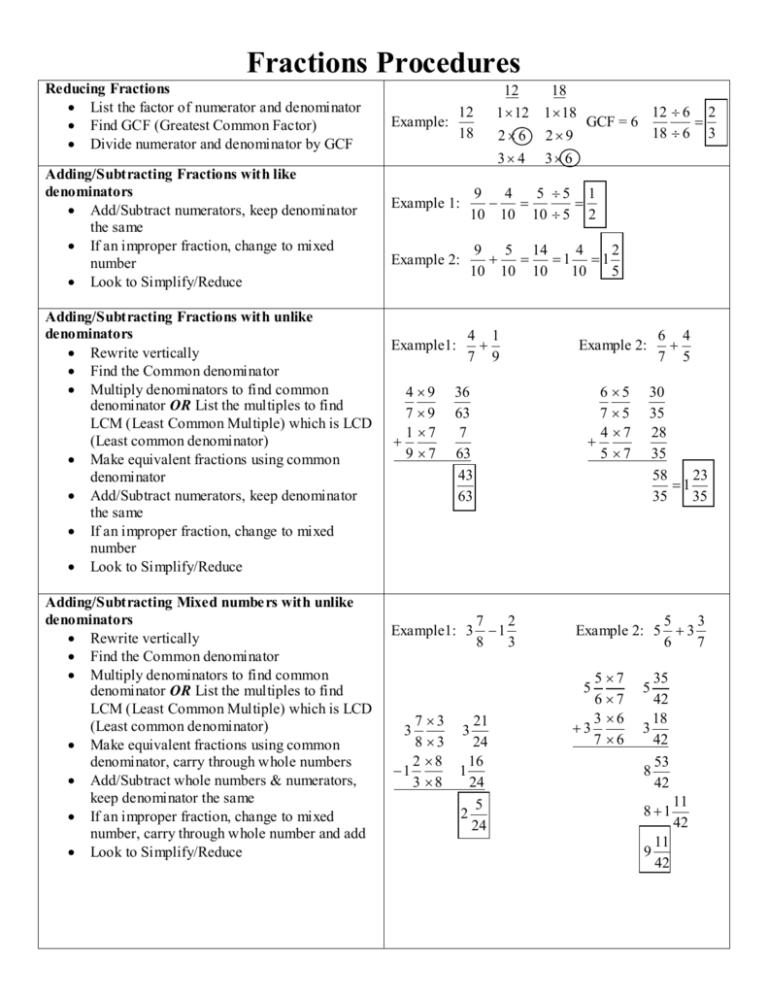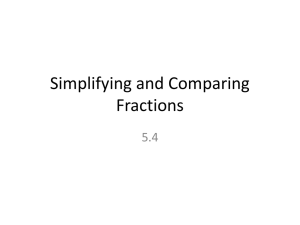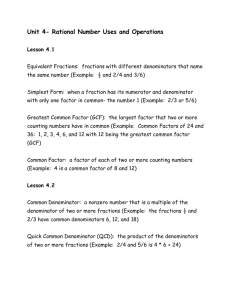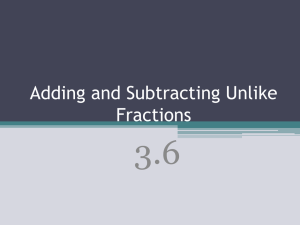Mr. Pomainville Fraction Procedures 2015
advertisement

Fractions Procedures Reducing Fractions List the factor of numerator and denominator Find GCF (Greatest Common Factor) Divide numerator and denominator by GCF Adding/Subtracting Fractions with like denominators Add/Subtract numerators, keep denominator the same If an improper fraction, change to mixed number Look to Simplify/Reduce Adding/Subtracting Fractions with unlike denominators Rewrite vertically Find the Common denominator Multiply denominators to find common denominator OR List the multiples to find LCM (Least Common Multiple) which is LCD (Least common denominator) Make equivalent fractions using common denominator Add/Subtract numerators, keep denominator the same If an improper fraction, change to mixed number Look to Simplify/Reduce Adding/Subtracting Mixed numbe rs with unlike denominators Rewrite vertically Find the Common denominator Multiply denominators to find common denominator OR List the multiples to find LCM (Least Common Multiple) which is LCD (Least common denominator) Make equivalent fractions using common denominator, carry through whole numbers Add/Subtract whole numbers & numerators, keep denominator the same If an improper fraction, change to mixed number, carry through whole number and add Look to Simplify/Reduce 12 18 Example: 12 18 12 6 2 1 12 1 18 GCF = 6 18 6 3 2 6 29 3 4 3 6 Example 1: 9 4 5 5 1 10 10 10 5 2 Example 2: 9 5 14 4 2 1 1 10 10 10 10 5 Example1: 4 1 7 9 4 9 7 9 1 7 9 7 36 63 7 63 43 63 7 2 Example1: 3 1 8 3 6 5 7 5 4 7 5 7 7 3 8 3 2 8 1 3 8 21 24 16 1 24 5 2 24 3 30 35 28 35 58 23 1 35 35 5 3 Example 2: 5 3 6 7 5 7 6 7 3 6 3 7 6 5 3 6 4 7 5 Example 2: 35 42 18 3 42 53 8 42 5 8 1 9 11 42 11 42 Multiplying Fractions without cross canceling Keep fractions written horizontally Multiply numerator times numerator Multiply denominator times denominator Look to Simplify/Reduce NOTE: You work with much larger numbers if you don't cross cancel ahead of time. Multiplying Fractions with cross canceling Keep fractions written horizontally Use cross cancel technique, you can cross cancel (diagonally) and (up and down) Look for GCF and divide it into each number that you are cross canceling Multiply what is left, numerator times numerator and denominator times denominator Look to Simplify/Reduce 5 12 60 15 4 9 15 135 15 9 Example 1: 6 2 5 5 12 60 6 6 Example 2: 12 9 3 9 9 1 9 1 4 5 12 4 Example 1: 9 15 9 3 3 4 5 5 12 2 20 6 Example 2: 12 3 9 9 1 3 3 NOTE: If you cross cancel correctly, you will never have to simplify/reduce. Multiplying Mixed Numbe rs Keep fractions written horizontally Change mixed numbers to improper fractions Refer to multiplying rules to continue Look to Simplify/Reduce Dividing Fractions Keep fractions written horizontally Change division to multiplication [COPY DOT FLIP] You are multiplying by the inverse or reciprocal Refer to multiplying rules to continue Look to Simplify/Reduce Dividing Mixed Numbe rs Keep fractions written horizontally Change mixed numbers to improper fractions Change division to multiplication [COPY DOT FLIP] You are multiplying by the inverse or reciprocal Refer to multiplying rules to continue Look to Simplify/Reduce 1 1 4 7 11 11 2 Example 1: 2 1 3 3 7 3 7 3 3 1 1 Example 1: 3 6 3 7 7 4 7 4 6 8 2 1 3 10 19 10 8 80 23 1 Example 1: 3 2 3 8 3 8 3 19 57 57







